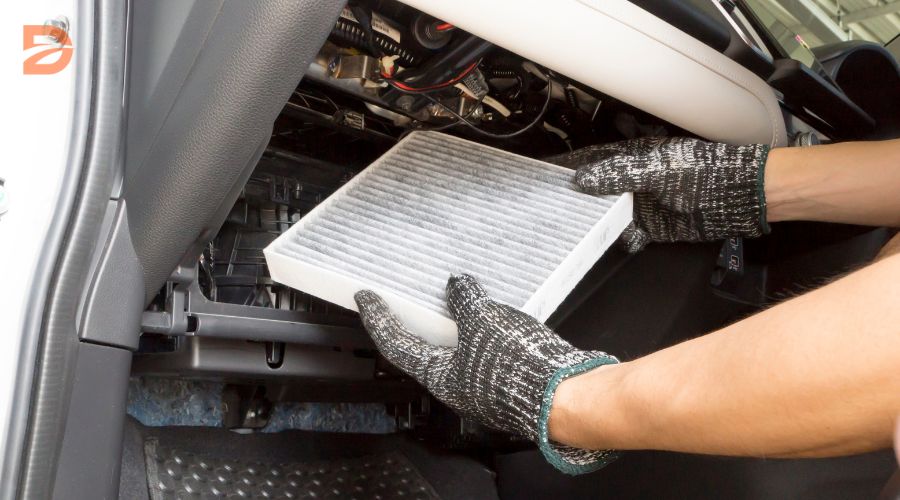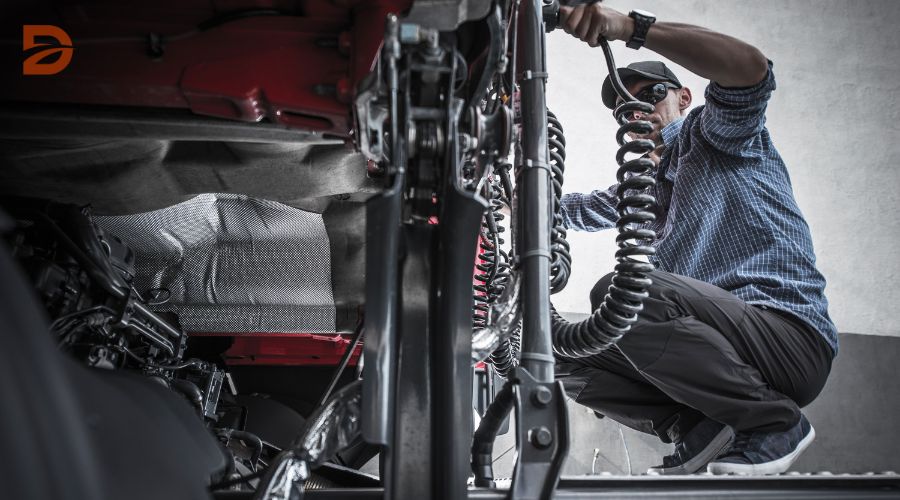Are you tired of unexpected vehicle breakdowns wreaking havoc on your fleet’s operations and bottom line? The secret to avoiding costly surprises may lie in the power of vehicle health monitoring and predictive maintenance (PdM). By harnessing the insights from real-time data, fleet managers can transform their operations, shifting from reactive to proactive maintenance strategies.
PdM uses advanced analytics to predict when fleet vehicles will need repairs, allowing you to address issues before they become major problems. Rather than waiting for a breakdown, you can stay one step ahead, optimizing vehicle uptime, reducing maintenance costs, and extending the lifespan of your assets. But how exactly can PdM save you money, and what should you consider when implementing it?
Key Takeaways
- Predictive maintenance leverages real-time telematics data to identify potential equipment failures before they occur, helping you avoid costly surprise repairs.
- By proactively addressing maintenance needs, PdM can reduce overall maintenance costs and boost vehicle uptime, improving fleet efficiency and safety.
- PdM can help extend the lifespan of your vehicles by preventing catastrophic failures, while also improving fuel efficiency through targeted diagnostics and maintenance.
- Implementing PdM requires careful consideration of your fleet’s unique needs, data infrastructure, and maintenance capabilities to ensure a successful program.
- Vehicle health monitoring empowers fleet managers to make data-driven decisions, streamlining operations and optimizing maintenance schedules.
Understanding Predictive Maintenance
Predictive Maintenance (PM) is a proactive approach that relies on advanced technology and data analytics to monitor the condition of equipment and predict when maintenance is required. Unlike traditional preventive maintenance, which follows a fixed schedule, PM utilizes sensors, Internet of Things (IoT) devices, and sophisticated algorithms to continuously assess the health of machinery and components.
What is Predictive Maintenance?
At its core, predictive maintenance aims to reduce overall maintenance costs and maximize asset lifespan by addressing potential failures before they occur. By continuously monitoring various parameters, such as vibration, temperature, and performance data, PM systems can detect early signs of deterioration and provide timely alerts for necessary maintenance actions.
The rise of IoT and advancements in data analytics have been instrumental in the widespread adoption of predictive maintenance. IoT devices integrated into vehicles and equipment gather real-time data, which is then analyzed using advanced algorithms to predict the remaining useful life of components and systems. This information enables fleet managers and maintenance teams to plan and execute maintenance activities precisely when needed, minimizing downtime and ensuring optimal equipment performance.
| Predictive Maintenance vs. Preventive Maintenance | Predictive Maintenance | Preventive Maintenance |
|---|---|---|
| Approach | Proactive, data-driven | Scheduled, time-based |
| Maintenance Trigger | Predicted need based on condition monitoring | Fixed schedule based on manufacturer recommendations |
| Outcome | Reduced maintenance costs, extended equipment lifespan | Potential for unnecessary maintenance, increased costs |
Industries that involve significant worker safety risks, use sensitive and expensive equipment, incur substantial capital and operational expenses, and suffer from major business disruptions due to equipment downtime stand to gain immensely from implementing predictive maintenance. By leveraging the power of predictive maintenance, IoT, data analytics, and condition-based monitoring, organizations can optimize their maintenance strategies and realize substantial cost savings while enhancing overall operational efficiency.
Potential Benefits of Predictive Maintenance
Embracing predictive maintenance (PdM) can unlock a wealth of benefits for fleet operations. By leveraging advanced technologies to monitor vehicle health in real-time, PdM eliminates the element of surprise when it comes to equipment breakdowns. This strategic approach significantly reduces the need for emergency shop visits, boosting asset availability and minimizing downtime reduction.
Moreover, PdM enhances fuel efficiency by identifying and addressing issues with critical engine and vehicle systems, such as oil degradation, intake/exhaust problems, cooling system malfunctions, and electrical system failures. By proactively addressing these concerns, fleet managers can ensure optimal performance and extended asset lifespan.
Predictive maintenance also plays a crucial role in improved safety. By anticipating potential issues like brake failures or suspension problems, fleet operators can address them before they escalate into larger, more dangerous incidents. This not only safeguards the well-being of drivers and passengers but also helps mitigate the risk of costly liability claims.
Ultimately, the maintenance cost reduction achieved through predictive maintenance strategies is a game-changer for fleet operations. By identifying and resolving problems before they lead to major breakdowns, PdM helps fleet managers maximize the return on their investment while ensuring the long-term reliability and performance of their vehicles.
Vehicle health monitoring, predictive maintenance
In the realm of fleet management, the power of telematics, sensor data, and condition-based maintenance is transforming the way vehicle health is monitored and maintained. Through advanced analytics, fleets can now proactively address potential issues before they escalate into costly breakdowns.
The predictive maintenance process collects data from various vehicle sensors to detect baseline deviations and trigger timely maintenance work orders. Telematics data such as engine performance, exhaust systems, transmission functions, and structural stability are analyzed to identify patterns that have led to distinct failures in the past. This allows the predictive maintenance solution to alert fleet managers in real-time about potential failures, weeks before they occur. By leveraging this data-driven approach, fleets can optimize vehicle uptime, reduce maintenance costs, and improve overall efficiency.
According to recent research, implementing 24/7 real-time remote equipment diagnostics and predictive maintenance can reduce fleet operating costs by up to 50%. Predictive maintenance is particularly suitable for advanced machines like mining and quarrying equipment, construction machinery, and specialized vehicles for oil and gas extraction, where monitoring over 10,000 possible parameters of equipment operation is achievable with telematics devices.
By embracing the power of vehicle health monitoring and predictive maintenance, fleets can not only minimize the risks of unexpected breakdowns but also extend the service life of their machinery through careful operation. This approach ensures that the technical team is well-prepared in advance, optimizing maintenance rapidity and contributing to improved fuel economy by preventing fuel consumption increases due to wear of fuel filters.
The future of fleet management lies in the seamless integration of telematics, sensor data, and condition-based maintenance strategies, empowering fleets to make data-driven decisions and achieve unparalleled efficiency and cost savings.
Implementing Predictive Maintenance
Implementing a successful predictive maintenance program in your fleet operations requires addressing several key considerations. Firstly, you need to have the right infrastructure and technology in place to capture and analyze the necessary data, such as fleet maintenance software with robust data-capturing capabilities.
Distributing training and resources to your fleet drivers and technicians is crucial so they can effectively monitor and respond to maintenance alerts. Determining the most valuable data to capture, such as fuel consumption, maintenance schedules, and compliance data, is also essential for your maintenance strategy.
Key Considerations
Fleet managers must understand when to use predictive maintenance versus other maintenance approaches, as each has its advantages and disadvantages depending on the specific needs of the fleet. Predictive maintenance, which involves using advanced data analytics and machine learning algorithms to detect early failure patterns and trends, can lead to smoother operations, increased performance, reliability, and extended lifespan of fleet vehicles.
- Sensor calibration and data integration for comprehensive data capture
- Advanced analytics and predictive alerts to optimize maintenance strategy
- Maintenance execution and continuous improvement to enhance infrastructure and training
| Best Practices for Predictive Maintenance | Benefits |
|---|---|
| Sensor Calibration and Data Integration | Comprehensive data capture for accurate insights |
| Advanced Analytics and Predictive Alerts | Optimized maintenance strategy to prevent breakdowns |
| Maintenance Execution and Continuous Improvement | Enhanced infrastructure and training for efficient operations |
“Implementing Predictive Maintenance can result in a significant reduction in unexpected breakdowns and costs in fleet management.”
Real-World Applications
In the fleet transportation and logistics sector, predictive maintenance is essential for maintaining fleet uptime and reducing operational costs. By monitoring vehicle sensors for signs of wear and tear, such as engine temperature, tire pressure, and brake performance, predictive maintenance solutions can identify potential issues before they lead to costly breakdowns.
One logistics fleet that implemented a predictive maintenance platform was able to quickly identify several underperforming trucks, with the platform revealing potential battery and brake failures, as well as other maintenance needs. This proactive approach allowed the fleet manager to prioritize critical repairs and avoid unexpected downtime. By anticipating necessary maintenance tasks, fleet managers can also schedule multiple services at once, minimizing the number of shop visits and reducing overall maintenance optimization.
Predictive maintenance solutions for automotive vehicles optimize engine performance, transmission function, exhaust systems, and vehicle structural stability, enhancing overall vehicle performance and longevity. The Heavy Vehicle Inspection (HVI) App utilizes AI to enhance vehicle inspections by analyzing historical data, sensor readings, and real-time diagnostics to identify potential issues before they become critical, maintaining vehicles in optimal condition.
Companies like General Electric (GE), Uber, UPS, Fleetio, Volvo Trucks, DHL, Samsara, Nauto, and Fleet Complete are leveraging predictive maintenance to optimize their fleet transportation and logistics operations, reducing downtime, maintenance optimization, and cost savings.
Conclusion
Predictive maintenance offers a transformative solution for fleet management, empowering operators to anticipate and address maintenance needs proactively. By leveraging data-driven insights from vehicle health monitoring, fleets can eliminate surprise repairs, reduce cost savings, improve safety, boost fuel efficiency, and extend vehicle lifespan. While implementing a successful predictive maintenance program requires overcoming certain challenges, the potential benefits in terms of operational efficiency and optimized performance make it a strategic investment for fleet managers.
As the technology continues to evolve, with more advanced sensors, analytics, and algorithms, predictive maintenance is poised to become an increasingly essential tool for fleet management and maintaining a competitive edge. The predictive maintenance benefits are clear, from minimizing downtime and compliance costs to enhancing safety and extending vehicle lifespans. Forward-thinking fleet operators who embrace this transformative approach will be well-positioned to drive their businesses to new heights of success.
The future of in-car health monitoring systems will involve sophisticated technologies such as sensors, facial recognition, eye tracking, and biometric analysis to enhance driver safety and provide personalized driving experiences. These systems will play a crucial role in autonomous driving scenarios by ensuring a smooth transition of control between the vehicle and the human driver, ultimately enhancing overall road safety and creating a more secure driving environment for all.
FAQ
What is predictive maintenance (PdM)?
Predictive maintenance (PdM) uses data to predict when fleet vehicles need repairs. By harnessing the power of data-driven insights, PdM empowers fleet managers to transform their operations. Instead of reacting to breakdowns, they can anticipate and address maintenance needs proactively.
How does predictive maintenance work?
PdM leverages real-time, customized telematics data to identify potential vehicle failures before they occur across all Class 1-8 vehicles. This helps avoid costly surprise repairs, reduce maintenance costs, improve fleet safety, boost fuel efficiency, and extend vehicle lifespan.
What are the key benefits of predictive maintenance?
Predictive maintenance offers a range of benefits for fleet operations, including eliminating surprise repairs, reducing the need for emergency shop visits, improving fleet safety, boosting fuel efficiency, and extending the lifespan of vehicles.
How does predictive maintenance collect and analyze data?
The predictive maintenance process collects data from various vehicle sensors to detect baseline deviations and trigger maintenance work orders. Telematics data such as engine performance, exhaust systems, transmission functions, and structural stability are analyzed to identify patterns that have led to distinct failures in the past.
What are the key considerations for implementing predictive maintenance?
Implementing a successful predictive maintenance program requires addressing several key considerations, such as having the right tools and technology, distributing training and resources, determining the most valuable data to track, and understanding when to use predictive maintenance versus other maintenance approaches.
Can you provide a real-world example of predictive maintenance in action?
One logistics fleet that implemented a predictive maintenance platform was able to quickly identify several underperforming trucks, with the platform revealing potential battery and brake failures, as well as other maintenance needs. This proactive approach allowed the fleet manager to prioritize critical repairs and avoid unexpected downtime.











